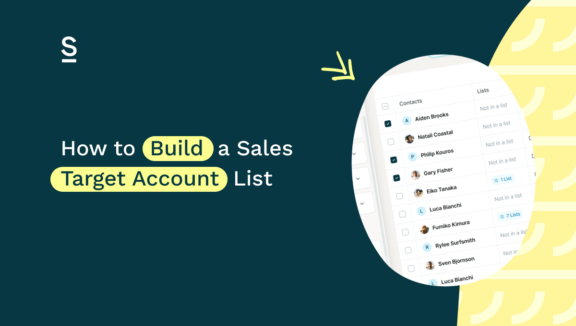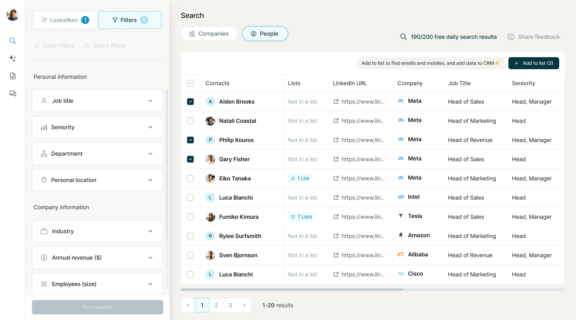How to Build a Sales Target Account List

We know that, in sales, time is money—and every minute spent chasing the wrong prospect is time wasted. What if you could optimize your outreach to only pursue viable leads that have a good chance of converting? With a well-curated target account list in hand, sales teams can do just that, and focus their efforts on the most promising leads, saving time, energy, and resources to close deals faster and more efficiently.
Sales professionals spend an average of 21% of their time searching for the right prospects. Imagine cutting that number in half—how many more deals could you close? Building a targeted account list is the first step toward improving your success rate, reducing time spent on prospecting dead ends, and aligning your efforts with potential customers who are most likely to convert.
In this article, we’ll show you how to refine your lists to really supercharge your selling. We’ll cover:
Define Your Ideal Customer Profile (ICP)
Before you can begin building a high-performing target account list, you need to know who you’re aiming at. Enter the Ideal Customer Profile (ICP), the foundation of any successful sales strategy.
What Is an ICP?
An ICP is a hypothetical description of the type of company that would benefit most from your product or service. It’s a strategic tool that helps you define the customers who not only fit your business but also offer the best long-term value. Think of it as a blueprint that guides your prospecting efforts and ensures you’re targeting the right accounts.
Why is the ICP crucial? It helps you:
- Focus your prospecting efforts on companies that align with your solution.
- Save time by filtering out leads that don’t fit your criteria.
- Increase your success rate by targeting companies who are more likely to see value in your offer.
What Should Your ICP Include?
To craft your ICP, you’ll need to understand three core types of data: demographics, firmographics, and psychographics. These will shape the profile of your ideal target.
- Industry: Which industries are most likely to need your product or service? Narrow your focus to the industries where your solution solves a significant problem or pain point.
- Company Size: Define size metrics such as revenue or employee count. Larger organizations might offer more opportunities for higher deal sizes, but they may also have longer sales cycles.
- Location: Consider geographical regions that are more likely to convert. For example, a tech product might perform better in innovation hubs like San Francisco or London.
- Challenges/Pain Points: Identify the key problems your product solves for potential customers. Understanding their specific pain points is crucial to tailoring your messaging and sales pitch.
Your ICP is the foundation upon which you build your sales target account list, so take the time to get it right. The more precise your ICP, the easier it will be to find high-quality prospects.
Gather Insights and Data
Data can be a sales team’s greatest asset in understanding more about the viability of your leads. Once you’ve defined your ICP, it’s time to gather the data to identify potential accounts that you should be targeting.
Leverage Internal Data
Your CRM is a treasure trove of insights. Analyze your previous customers to find trends, such as:
- Companies with higher deal sizes
- Industries where your product has a strong track record
- Customers with high retention rates
By understanding the characteristics of your best customers, you can narrow your focus to similar prospects.
External Data Sources
Internal data alone isn’t enough. To build a comprehensive target account list, you’ll also need external data. Third-party tools and databases can help you enrich your data, giving you insights into companies that align with your ICP.
In fact, 9 out of 10 companies use lead enrichment tools to learn more about prospects. Some examples of valuable tools include:
- Lead enrichment software that pulls in contact information and company data
- Industry reports that provide insights into market trends and key players
- Sales intelligence platforms that help you track engagement and buying signals
Getting More Out of LinkedIn
Don’t overlook the power of LinkedIn. As a B2B salesperson, LinkedIn can be one of the most effective platforms for targeting the right accounts. Over 80% of prospects are open to communicating with sellers via social media, making LinkedIn a goldmine for networking and prospecting.
By combining internal data with external resources like LinkedIn and lead enrichment tools, you’ll have a clearer, more complete picture of your target accounts.
Prioritize Accounts Based on Key Metrics
Not all prospects are created equal. To maximize your sales efforts, it’s essential to prioritize your target accounts based on their potential value and likelihood to convert.
Scoring System
The easiest way to prioritize your leads is by creating a scoring system. Assign scores to each account based on factors like:
- Revenue potential: How large is the company, and what is their buying capacity? Focus on industries and companies where high-value deals are more likely.
- Ease of closing: Target companies that resemble your existing success stories or case studies. If your product has a proven track record with similar businesses, you’ll likely face fewer objections.
- Engagement and intent data: Tools that track web engagement, email responses, and social selling efforts can provide critical insights into which accounts are already showing interest. Prioritize those that have visited your website or engaged with your content.
Remember, nurtured leads produce a 20% increase in sales opportunities. By focusing on prospects who have already shown some level of engagement, you’re targeting accounts that are closer to making a buying decision.
Leverage Referral Networks
There’s nothing quite as powerful as a warm introduction. In fact, 84% of buyers start their purchasing process with a referral. Referrals are a fast track to landing target accounts. A recommendation from a trusted source can significantly reduce the time spent convincing a prospect of your product’s value.
How to Generate Referrals
Referrals don’t happen by accident. Here are a few strategies to help you grow your army of brand advocates:
- Ask existing customers: Happy clients are often willing to introduce you to their peers in similar industries. Don’t hesitate to ask for a referral after a successful deal.
- Leverage your network: Your personal and professional networks are invaluable for introductions. Engage with your connections, offer value, and ask for referrals when appropriate.
- Partner with complementary companies: Develop partnerships with companies that offer complementary services or products. They can refer you to their clients when your solutions align.
Building a referral network can significantly enhance your ability to reach new target accounts while building trust right from the start.
Segment and Organize Your Target List
Not every prospect is ready to buy at the same time. By segmenting your list based on the buyer’s journey, you can tailor your outreach and messaging accordingly. For example:
- Awareness stage: These prospects are just starting to identify a problem. Provide educational content to help them understand their pain points and how your product addresses them.
- Consideration stage: These accounts know they have a problem and are evaluating solutions. Focus on differentiating your product and showing why you’re the best fit.
- Decision stage: Prospects in this stage are ready to buy. Offer case studies, demos, and personalized outreach to help them make their final decision.
Assign Sales Reps
Match the right sales reps to the right accounts. If one of your reps has a history of success in US healthcare companies, for example, make sure to assign them accounts in similar industries or regions.
Set Priorities
Use a tiered system to rank your accounts. This might look something like the below:
- Tier 1: High-priority accounts with the greatest revenue potential.
- Tier 2: Mid-tier accounts that may convert with the right nurturing.
- Tier 3: Low-priority accounts that are not yet ready to buy but are worth staying on the radar.
This system ensures you’re managing your time effectively and focusing on the accounts with the highest potential.
But hold up a second…
We’re talking about segmenting and organizing lists.. but where are we doing organizing them?
Well, where do you usually organize them?
Most sales people are using a mixture of LinkedIn Sales Navigator and their CRM. Sales Navigator is great for finding people but then it kind of stops being helpful there, and your CRMs are great places for storing and managing contacts but how do you find them initially?
What if we told you there was a new tool that blends the precision of Sales Navigator’s ability to find qualified leads with your CRM’s reliability of managing your contacts?
You can now identify target companies and people with Surfe. Find accounts or leads that match your ICP or identify lookalike companies based on existing clients. Once you start adding people to your Surfe lists, this is where the magic really happens…
Have you heard of data enrichment? (I hope so…)
What about waterfall enrichment?
Surfe is introducing intelligent waterfall enrichment to the world of sales – by combining the power of the leading enrichment tools, you benefit from global coverage with local precision.
And just like that, with one click, your lead list is enriched with validated email addresses and phones numbers with a 93% find rate in one click.

Regularly Update and Refine Your List
The only thing worse than not using a target account list is using one that’s outdated. Your list isn’t static—it should be continuously refined based on insights from recent sales, customer feedback, and market trends.
In fact, 67% of lost sales are due to not properly qualifying potential customers. Avoid this mistake by regularly reviewing your list and updating it with new data, insights, and lessons learned.
Track Key Performance Indicators (KPIs)
To ensure your target account list is delivering results, track these KPIs:
- Lead conversion rate: How many of your target accounts are turning into leads?
- Close rate on target accounts: How often are accounts from your list converting into customers?
These metrics will help you identify which accounts are worth pursuing and where you need to adjust your strategy.
Let’s Wrap It Up!
Building a sales target account list is both an art and a science. By defining your ICP, gathering data, prioritizing prospects, leveraging referrals, and continuously refining your list, you’ll create a roadmap that guides you toward high-value deals and faster closes.
A well-curated list ensures that your time and energy are directed where they’ll have the most impact, helping you execute better outreach campaigns and ultimately land more sales.

Ready to reach the right prospects?
Surfe’s email finder enriches your lead lists with up-to-date contact information. And with a 93% find rate, it’s one of the best in the market.
Frequently Asked Questions (FAQs)
How often should I update my target account list?
Regular updates are crucial. Aim to revisit and refine your list at least once a quarter to ensure you’re focusing on the right prospects.
What tools should I use for lead enrichment?
Surfe’s email finder helps you enrich contact records and lead lists with up-to-date email addresses so you know your outreach campaigns have the best chance of being read.
How do I know if my ICP is correct?
Regularly evaluate your success metrics. If you find that your win rates are low, or you’re not closing deals with target accounts, revisit your ICP and adjust based on new insights.


